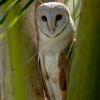Sexes alike. Dull golden-buff above, finely speckled black and white; white below, often with fine , dark spots; heart-shaped, white facial disc striking. Solitary or in pairs; nocturnal, but sometimes hunts during day; normally rests during day, mostly in a tree-cavity, dense creepers or some dark loft; perches upright; flies silently, mostly under 4m from ground; pounces on prey.
- Browse
- Gallery
- Checklists
- Topography
- Glossary
- Bibliography
- Feedback
- About Us










